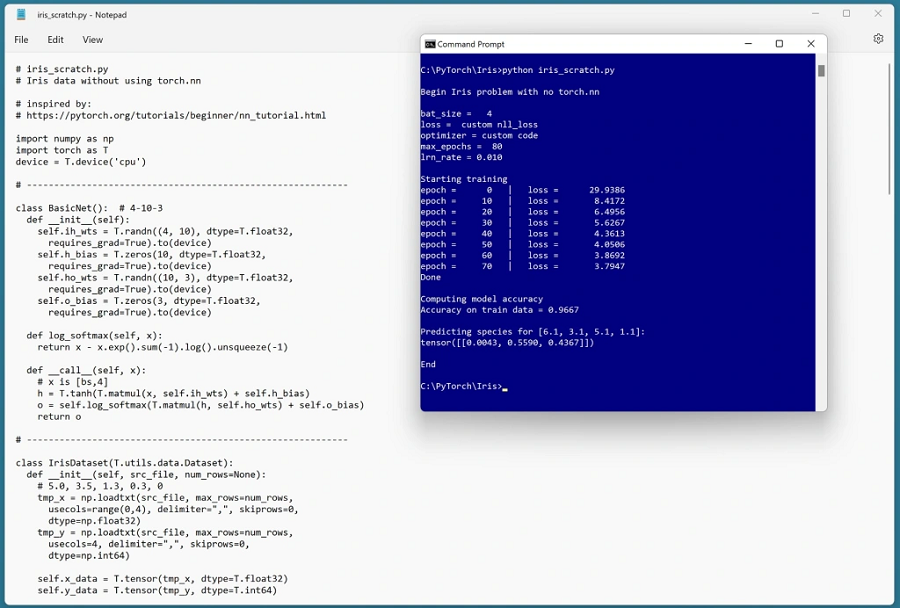出于好奇,我决定尝试在低级层面实现 PyTorch 神经网络。我的意思是不使用封装了大量功能的 torch.nn 模块。
我编写了一个演示。需要处理的细节比我想象的要多得多,编写代码所花的时间也比我想象的要长得多。

NSDT工具推荐: Three.js AI纹理开发包 - YOLO合成数据生成器 - GLTF/GLB在线编辑 - 3D模型格式在线转换 - 可编程3D场景编辑器 - REVIT导出3D模型插件 - 3D模型语义搜索引擎 - Three.js虚拟轴心开发包 - 3D模型在线减面 - STL模型在线切割
这篇博文不涉及一般概念——它只涉及代码细节。我已经使用 C# 和 Python 从头实现了数百个神经网络,并且使用 PyTorch 实现了数百个神经网络。即便如此,我在不使用 torch.nn 模块的情况下实现 PyTorch 神经网络时还是遇到了很大困难。
但我从概念挑战中学到了很多东西,所以这段时间花得很值。
示例代码:
# iris_scratch.py
# Iris data without using torch.nn
# inspired by a similar experiment at:
# https://pytorch.org/tutorials/beginner/nn_tutorial.html
import numpy as np
import torch as T
device = T.device('cpu')
# -----------------------------------------------------------
class BasicNet(): # 4-10-3
def __init__(self):
self.ih_wts = T.randn((4, 10), dtype=T.float32,
requires_grad=True).to(device)
self.h_bias = T.zeros(10, dtype=T.float32,
requires_grad=True).to(device)
self.ho_wts = T.randn((10, 3), dtype=T.float32,
requires_grad=True).to(device)
self.o_bias = T.zeros(3, dtype=T.float32,
requires_grad=True).to(device)
def log_softmax(self, x):
return x - x.exp().sum(-1).log().unsqueeze(-1)
def __call__(self, x):
# x is [bs,4]
h = T.tanh(T.matmul(x, self.ih_wts) + self.h_bias)
o = self.log_softmax(T.matmul(h, self.ho_wts) +
self.o_bias)
return o
# -----------------------------------------------------------
class IrisDataset(T.utils.data.Dataset):
def __init__(self, src_file, num_rows=None):
# 5.0, 3.5, 1.3, 0.3, 0
tmp_x = np.loadtxt(src_file, max_rows=num_rows,
usecols=range(0,4), delimiter=",", skiprows=0,
dtype=np.float32)
tmp_y = np.loadtxt(src_file, max_rows=num_rows,
usecols=4, delimiter=",", skiprows=0,
dtype=np.int64)
self.x_data = T.tensor(tmp_x, dtype=T.float32).to(device)
self.y_data = T.tensor(tmp_y, dtype=T.int64).to(device)
def __len__(self):
return len(self.x_data)
def __getitem__(self, idx):
if T.is_tensor(idx):
idx = idx.tolist()
preds = self.x_data[idx]
spcs = self.y_data[idx]
return preds, spcs
# -----------------------------------------------------------
def nll_loss(predicted, target):
return -predicted[range(target.shape[0]), target].mean()
# -----------------------------------------------------------
def accuracy(model, dataset):
# assumes model.eval()
dataldr = T.utils.data.DataLoader(dataset, batch_size=1,
shuffle=False)
n_correct = 0; n_wrong = 0
for (_, batch) in enumerate(dataldr):
X = batch[0]
Y = batch[1] # already flattened by Dataset
with T.no_grad():
oupt = model(X) # logits form
big_idx = T.argmax(oupt)
# if big_idx.item() == Y.item():
if big_idx == Y:
n_correct += 1
else:
n_wrong += 1
acc = (n_correct * 1.0) / (n_correct + n_wrong)
return acc
# -----------------------------------------------------------
def main():
print("\nBegin Iris problem with no torch.nn ")
# 0. prepare
T.manual_seed(1)
np.random.seed(1)
# 1. load data
train_file = ".\\Data\\iris_train.txt"
train_ds = IrisDataset(train_file, num_rows=120)
bat_size = 4
train_ldr = T.utils.data.DataLoader(train_ds,
batch_size=bat_size, shuffle=True)
# 2. create network
net = BasicNet()
# 3. train model
max_epochs = 80
ep_log_interval = 10
lr = 0.01
loss_func = nll_loss # see above
# optimizer = T.optim.SGD(net.parameters(),
# lr=lrn_rate) # no parameters
print("\nbat_size = %3d " % bat_size)
print("loss = " + " custom nll_loss" )
print("optimizer = custom code")
print("max_epochs = %3d " % max_epochs)
print("lrn_rate = %0.3f " % lr)
print("\nStarting training")
for epoch in range(0, max_epochs):
epoch_loss = 0 # for one full epoch
for (batch_idx, batch) in enumerate(train_ldr):
X = batch[0] # [10,4]
Y = batch[1] # OK; alreay flattened
oupt = net(X)
loss_val = loss_func(oupt, Y) # a tensor
epoch_loss += loss_val.item() # accumulate
loss_val.backward() # compute gradients
# torch.optimizer.step()
# leaf Var in place
with T.no_grad(): # update weights
net.ih_wts -= net.ih_wts.grad * lr
net.h_bias -= net.h_bias.grad * lr
net.ho_wts -= net.ho_wts.grad * lr
net.o_bias -= net.o_bias.grad * lr
# torch.optimizer.zero_grad()
net.ih_wts.grad.zero_() # get ready for next update
net.h_bias.grad.zero_()
net.ho_wts.grad.zero_()
net.o_bias.grad.zero_()
if epoch % ep_log_interval == 0:
print("epoch = %6d | loss = %12.4f " % \
(epoch, epoch_loss) )
print("Done ")
# 4. evaluate model accuracy
print("\nComputing model accuracy")
acc = accuracy(net, train_ds) # item-by-item
print("Accuracy on train data = %0.4f" % acc)
# 5. make a prediction
print("\nPredicting species for [6.1, 3.1, 5.1, 1.1]: ")
unk = np.array([[6.1, 3.1, 5.1, 1.1]], dtype=np.float32)
unk = T.tensor(unk, dtype=T.float32).to(device)
with T.no_grad():
logits = net(unk) # values do not sum to 1.0
probs = T.softmax(logits, dim=1)
T.set_printoptions(precision=4)
print(probs)
print("\nEnd ")
# -----------------------------------------------------------
if __name__ == "__main__":
main()原文链接:不用nn.Module - BimAnt






















 被折叠的 条评论
为什么被折叠?
被折叠的 条评论
为什么被折叠?








